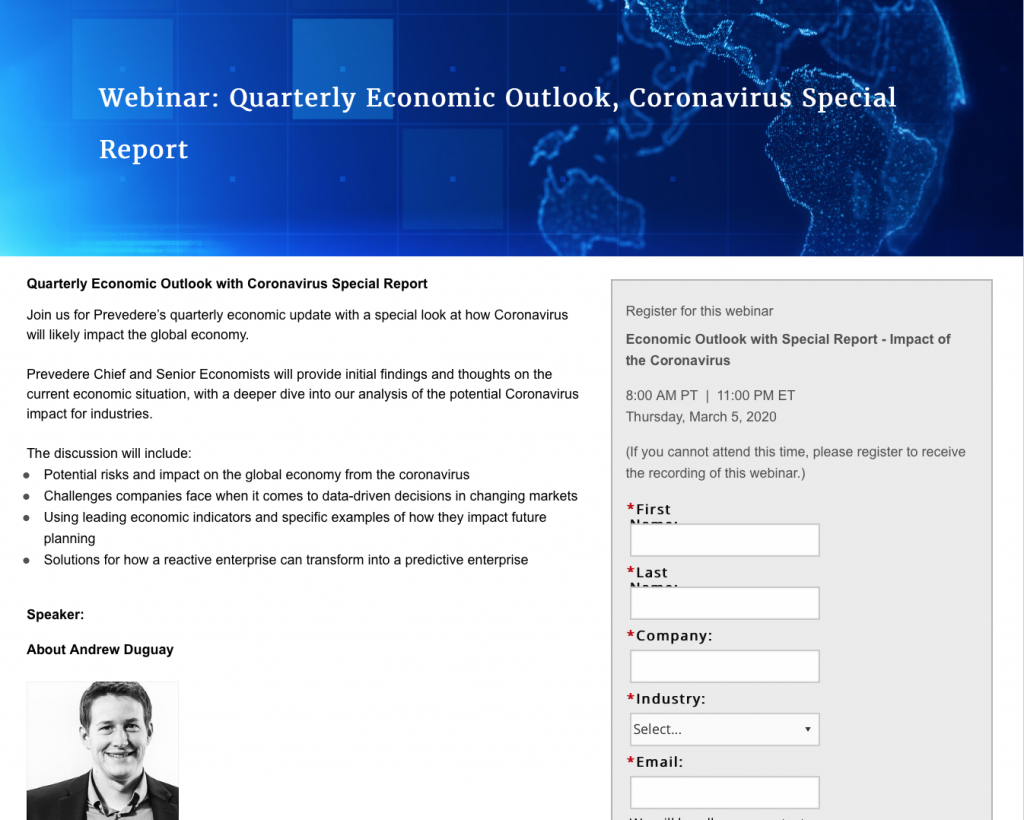Last Updated: April 9, 2020
In recent days, the spread of the coronavirus has brought many questions and concerns about the economic impact of the coronavirus and the future outlook for 2020. Businesses have been reporting negative impacts in their quarterly earnings, the stock market has taken notice, and questions linger on how profound and how long the impact will be, globally and regionally, across different market segments and industries.
Given Prevedere’s role as a premier predictive analytics solution that examines global external factors to measure potential impacts on future business performance, our team has been fielding questions about the impact developments will have on financial models. While there is much information that we cannot measure, such as how severe the coronavirus outbreak will ultimately be and how long it will last, we can look to a multitude of sources for signals and clues to the current financial impact the virus is having globally and the impact on business performance.
Challenges lie ahead when measuring the economic impact of the coronavirus.
The recent onset and rapid escalation of the virus constitute that the resulting economic impact is measured primarily in days or weeks. Typically government sources of information regarding economic performance are mainly measured in months and quarters when taking into account the lag between the time measured and the release of the data. The gap means we cannot yet look at many traditional measurements like consumer spending and manufacturing trends to isolate impacts.
Increasingly, however, there are more real-time datasets available that we can reference, such as indexed measures of weekly consumer spending in China, which we are currently monitoring. Such data shows a substantial drop-off in consumer spending in the latter half of January across multiple categories that reflect more severe seasonal trends than the impact of the Chinese New Year alone would suggest.
So what should we expect for the coming months and year?
It is important to note that most economic research suggests the lingering economic effect after a virus epidemic containment is typically 1-4 months, followed by 1-2 quarters of recovery, with GDP gaining back most of the lost production as firms and consumers ramp up production and restock after the temporary hiatus. 2020 does not have to be a down year, as first-half weakness can become assuaged with near-equal recovery in the second half.
The risk inherent with the economic impact of the coronavirus is obviously on the downside. Added economic pressures are that there are already other macroeconomic factors, aside from the coronavirus, that are suggesting slower global growth conditions for 2020. It is increasingly beneficial to stay attuned to the economic signals as they are released.
As more data becomes available, below are some areas Prevedere is continuing to monitor and report on:
- Imports/Exports
- Travel
- Stock Market Fluctuations
- Electricity Demand
- Manufacturing Output
- Consumer Spending
- Consumer Sentiment
Knowing what unique business drivers are, what they suggest for 2020, and how the economic impact of the coronavirus may impact those expectations is critical in this time of uncertainty. Prevedere’s unique Intelligent Forecasting solution mix brings a potent combination of game-changing new technologies, from big data to cloud processing power to machine learning, to bear on investigating this incredibly rich, global data. Now we can leverage vast aggregations of data and apply massive amounts of computing power to find and apply the data that’s most relevant to business, and, using that continually updating data, generate intelligent models that learn and adapt in real-time to changing events. We are here to help dive into those questions and prepare organizations for the challenges that may be ahead, and importantly watch for leading signals of when recovery is on the horizon.

- Potential risks and impact on the global economy from the coronavirus
- Challenges companies face when it comes to data-driven decisions in changing markets
- Using leading economic indicators and specific examples of how they impact future planning
- Solutions for how a reactive enterprise can transform into a predictive enterprise
***
Tapping into Economic Indicators to Seize Market Opportunity and Momentum

Until recently, finding the right data to forecast a company’s future business prospects was like finding a needle in a haystack. One reason is all the data available today. The problem becomes filtering the gazillion data elements to find kernels of insight. Unable to process all that information manually, the unique business indicators are unattainable and unfathomable.
This challenge confronts every CFO in making strategic plans and capital decisions, and Financial Planning and Analysis (FP&A) teams generating forecasts based on historical financial performance and current macroeconomic trends. In “Tapping into Economic Indicators to Seize Market Opportunity and Momentum,” Russ Banham, Pulitzer Prize-nominated financial journalist, guides readers through the big data challenges companies face and solutions for navigating and strategically planning for the future.